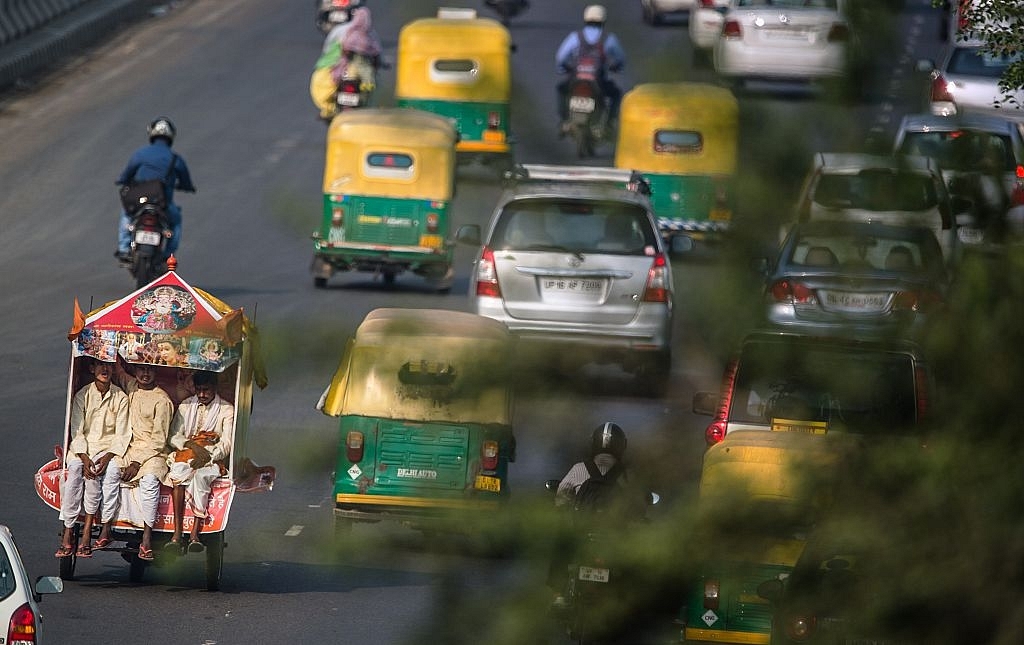Books
Looking To Even The Odds: Replace Slow Vehicles To Combat Pollution
- A city’s traffic only moves as fast as it’s slowest vehicleIn Delhi, that would mean the auto-rickshawsSo, is there a solution to this auto-rickshaw problem?

Delhi auto-rickshaws
The Odd-Even plan is back in Delhi. However, whether it is successful or a disaster seems to depend more on one’s political leaning than that of reality. In this war of one-upmanship, the so-called common man has long been forgotten by the political parties.
Delhi Chief Minister Arvind Kejriwal, who excels in providing simplistic solutions to complex problems, like trying to eliminate bribery not by simplifying rules but by recording the conversation, has again chosen to solve the pollution-cum-traffic problem by an equally simple solution of the Odd-Even rule. The plan that covers less than 10% of total vehicles and with a long exemption list has delighted the exempted, non-Delhi residents and armchair experts, though data on pollution and experience on road speaks otherwise.
As per estimates, the total number of vehicles expected to be off road (in this case private cars) are less than 10% of total number of vehicles on the road. So far, evidence is indicating the fallacy of such a plan where the traffic has indeed become better but there is no drop in pollution at all.
While the jury is still out on the real cause of pollution to whether it is dust, smoke from burning crops, emissions of diesel vehicles or smoke emitted by cars, there is unanimous view among the citizens for the need to reduce usage of personal automobiles and encourage public transport.
All across the world the authorities are trying to reduce private vehicles. However, it is easier said than done as it needs massive rethinking as well as state intervention in terms of city planning, design, capacity building along with attitude shifting.
However, in this high-pitched debate about Odd-Even, experts seem to be overlooking the issue of speed. Vehicles caught in traffic jams or moving slowly cause more pollution than the same number of vehicles moving at optimal speed.
When traffic is chaotic and moves at a slow place, a driver uses the clutch and brake combination, and releases more smoke/un-burnt fuel in the air. In Delhi, 22 December 2015 was No Car Day. But it saw massive traffic snarls all across east Delhi due to non-operation on Vikas Marg and it was the most polluted night in the history of the city.
The first phase of the Odd-Even plan did see an increase in city speed initially as a number of vehicles stayed off the road. However, blinded by short-term success, the Delhi Government launched the second phase, which suddenly saw huge serpentine jams.
By dictating a Tughlaqi order, a government can’t eliminate the needs of the people and can’t wish them to disappear without providing alternative means. Hence, the second phase of Odd-Even is struggling and doesn’t seem to have made a dent in pollution or in road speed.
While reducing the number of vehicles on the road can impact the speed of vehicles in a city, it can be increased in a more sustainable manner by regulating the speed of the slowest vehicle on the road. Dr. Eliyahu M. Goldratt in his seminal book The Goal demonstrated that speed of any system is determined by its slowest moving part.
The slowest vehicle on Delhi’s roads is the autorickshaw or the goods carrier. Hence, Delhi moves at a speed of 30 kmph not because of excessive vehicles on the road but because of the speed of auto-rickshaws and the goods carriers. On Delhi’s roads one encounters a fully-loaded Bajaj auto struggling to climb a flyover at a speed of 25 kmph and a long queue of slowing traffic behind.
So the pollution level can be dropped drastically if the average speed can be increased by 25/30 kmph as it will eliminate jams. So what’s the solution? Ban autorickshaws and earn the ire of the middle class as well as erode the massive vote bank of auto drivers? Yes, actually!
This solution is quite simple if one moves away from the politics of it. The only thing the government needs to do is to replace a slow-moving auto-rickshaw with a car. Cars are safer, faster and are all-weather vehicles unlike an auto. Further, the cost of an auto is around INR 2 lakh and add another lakh or so for permit / convenience fee, etc. In comparison, Tata Nano CNG car costs close to 2.5 lakh. So rather than issuing new auto permits, the Government should launch a massive auto upgrade program which with proper structuring / debt plan can enable all auto-owners to shift to the Tata Nano.
With a total population of 1 lakh auto rickshaws, the whole program can be done at a cost of less than Rs 250 Cr as a one-time cost (Complete makeover cost is Rs 2500 Cr).
Such an upgrade will mean 10x more in terms of savings in fuel costs / health care and cleaner air. However, such a move needs political will and desire to solve issues with a long-term view. Unfortunately, pollution in Delhi is more about politics.
So whether it is pollution or governance, the victim is always the Great Indian Citizen. Ever optimistic, forever cheated!
Introducing ElectionsHQ + 50 Ground Reports Project
The 2024 elections might seem easy to guess, but there are some important questions that shouldn't be missed.
Do freebies still sway voters? Do people prioritise infrastructure when voting? How will Punjab vote?
The answers to these questions provide great insights into where we, as a country, are headed in the years to come.
Swarajya is starting a project with an aim to do 50 solid ground stories and a smart commentary service on WhatsApp, a one-of-a-kind. We'd love your support during this election season.
Click below to contribute.
Latest